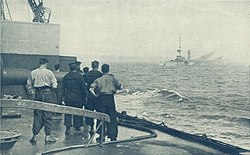
Back معركة خليج هيليغولاند (1914) Arabic Бітва ў Гельгаландскай бухце Byelorussian První bitva u Helgolandské zátoky Czech Seegefecht bei Helgoland (1914) German Batalla de la bahía de Heligoland (1914) Spanish Helgolandin taistelu (1914) Finnish Bataille de Heligoland (1914) French קרב מפרץ הלגולנד הראשון HE Helgolandi csata (1914) Hungarian Pertempuran Teluk Heligoland ID
| Battle of Heligoland Bight (1914) | |||||||
|---|---|---|---|---|---|---|---|
| Part of the First World War | |||||||
 German light cruiser SMS Mainz shortly before heeling over and sinking, 28 August 1914 | |||||||
| |||||||
| Belligerents | |||||||
|
|
| ||||||
| Commanders and leaders | |||||||
|
|
| ||||||
| Strength | |||||||
|
5 battlecruisers 8 light cruisers 33 destroyers 8 submarines |
6 light cruisers 19 torpedo boats 12 minesweepers | ||||||
| Casualties and losses | |||||||
|
35 killed 55 wounded 1 light cruiser damaged 3 destroyers damaged |
712 killed 149 wounded 336 captured 3 light cruisers sunk 1 torpedo boat sunk 3 light cruisers damaged 3 torpedo boats damaged | ||||||
The battle location in the North Sea | |||||||
The Battle of Heligoland Bight was the first Anglo-German naval battle of the First World War, fought on 28 August 1914, between ships of the United Kingdom and Germany. The battle took place in the south-eastern North Sea, when the British attacked German patrols off the north-west German coast. The German High Seas Fleet was in harbour on the north German coast while the British Grand Fleet was out in the northern North Sea. Both sides engaged in long-distance sorties with cruisers and battlecruisers, with close reconnaissance of the area of sea near the German coast—the Heligoland Bight—by destroyer.
The British devised a plan to ambush German destroyers on their daily patrols. A British flotilla of 31 destroyers and two cruisers under Commodore Reginald Tyrwhitt, with submarines commanded by Commodore Roger Keyes, was dispatched. They were supported at longer range by an additional six light cruisers commanded by William Goodenough and five battlecruisers commanded by Vice Admiral David Beatty.
Surprised, outnumbered and outgunned, the German fleet suffered 712 sailors killed, 530 injured and 336 taken prisoner; three German light cruisers (SMS Ariadne, Cöln and Mainz) and one torpedo boat (SMS V187) were sunk; three more light cruisers (SMS Strassburg, Stettin and Frauenlob) and three torpedo boats suffered damage. The British suffered casualties of 35 killed and 55 wounded; one light cruiser and three destroyers suffered damage. Despite the disparity of the ships involved in the battle, the battle was regarded as a great victory in Britain, where the returning ships were met by cheering crowds.
Beatty was vaunted as a hero, although he had taken little part in the action or planning of the raid, which was led by Commodore Tyrwhitt and conceived by him and Keyes, who had persuaded the Admiralty to adopt it. The raid might have led to disaster, had the additional forces under Beatty not been sent by Admiral John Jellicoe at the last minute. The German government and the Kaiser in particular, restricted the freedom of action of the German fleet, instructing it to avoid any contact with superior forces for several months thereafter.
